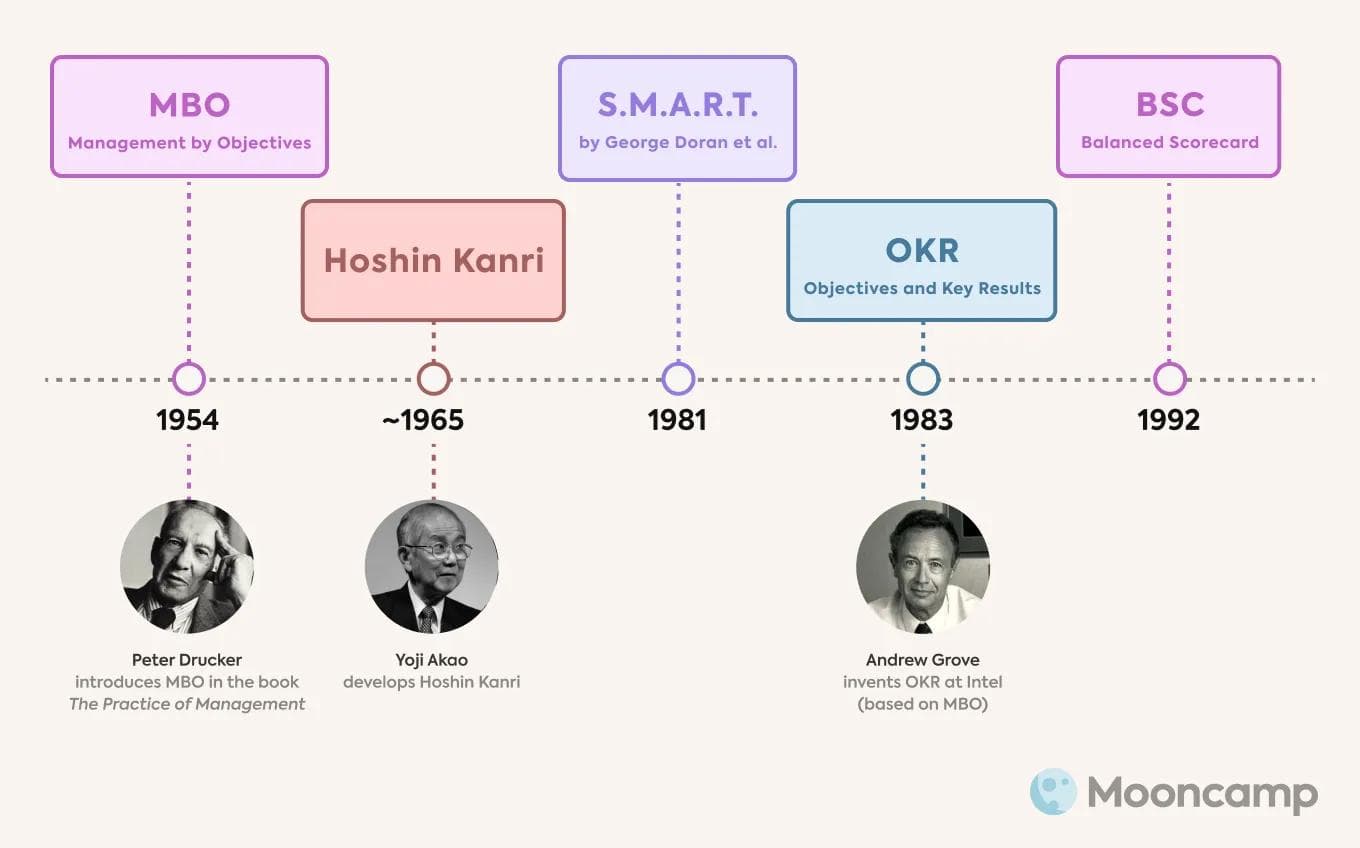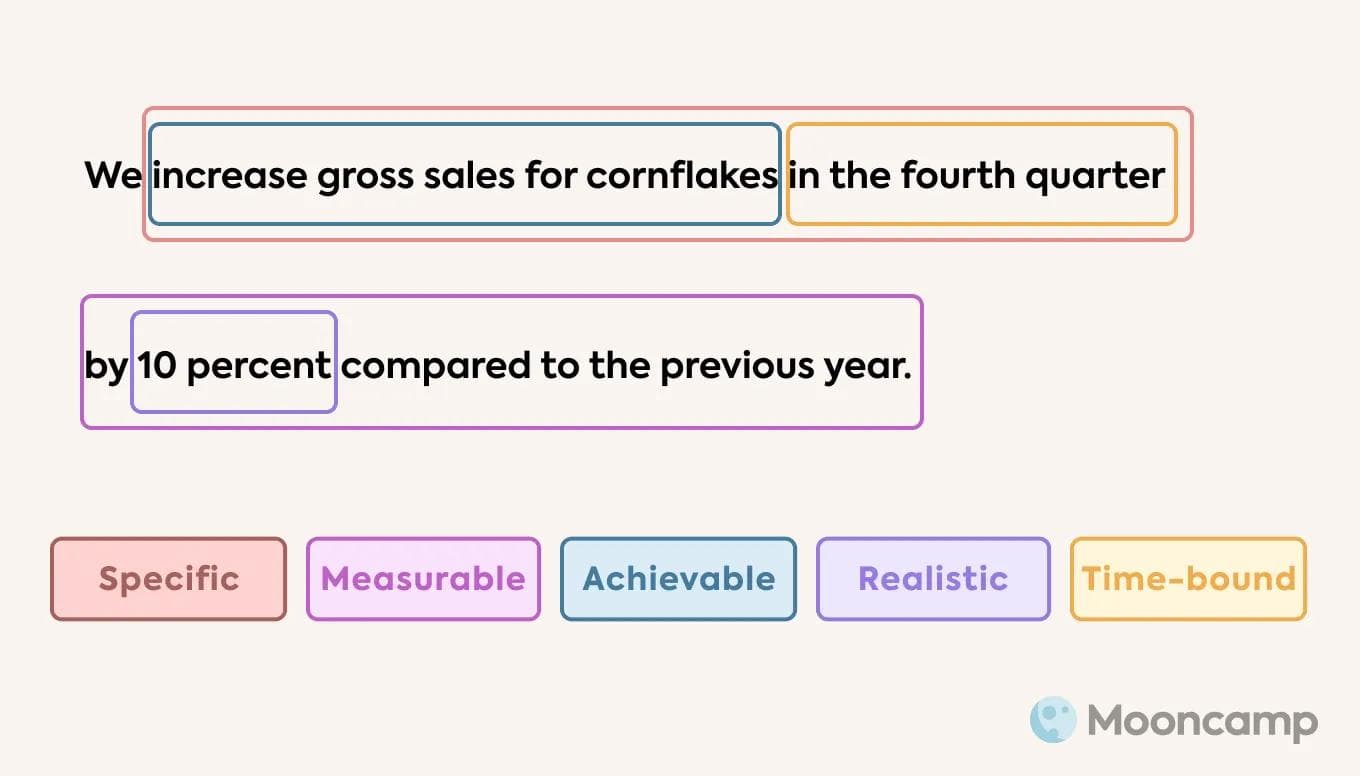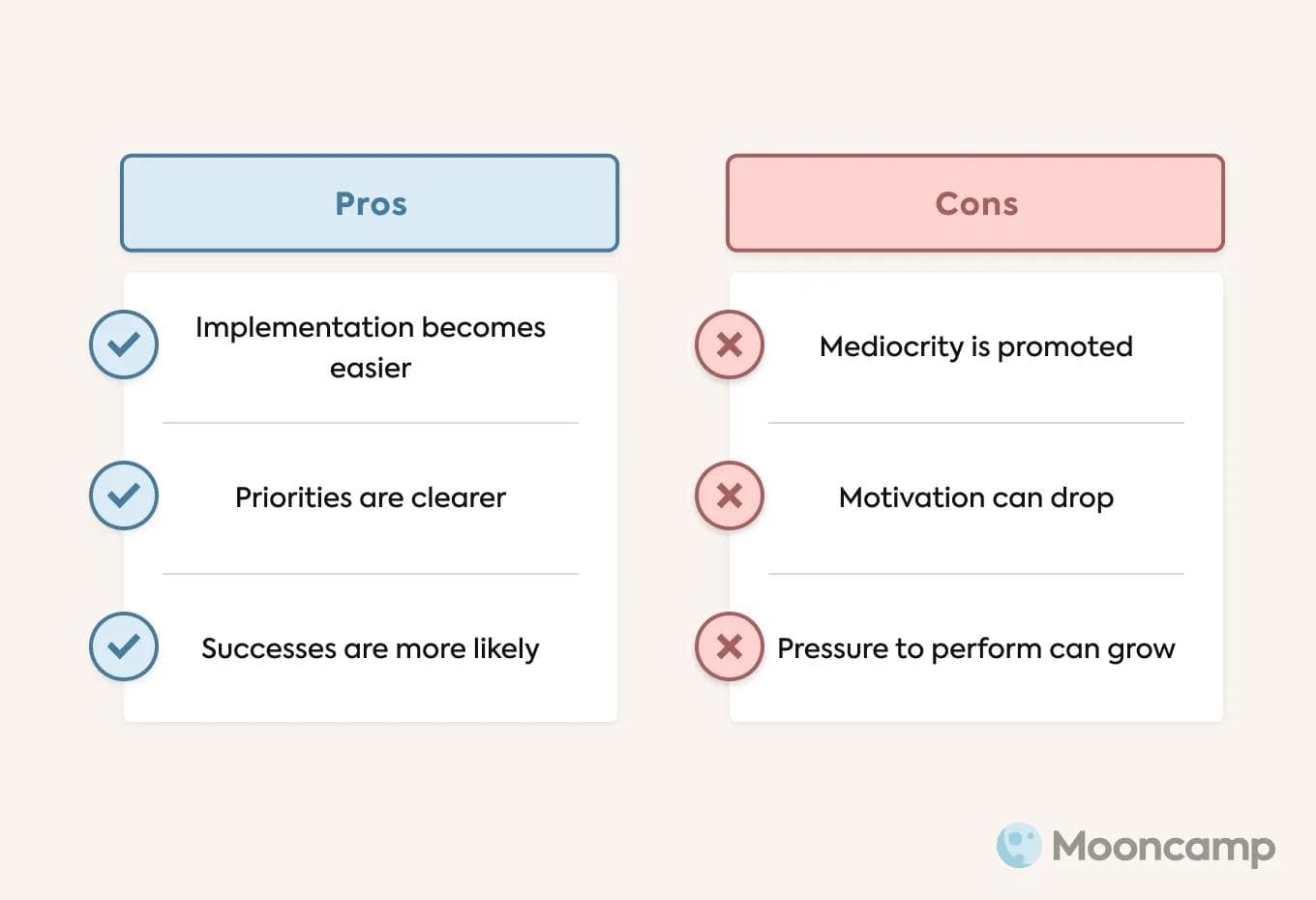SMART goals: How they work and in which way they relate to OKRs

You have to set goals if you want to be successful. You can do this in many different ways – and not all of them are equally effective. The reason for this are usually the goals themselves: The way a goal is formulated influences how likely it is to actually be achieved. In other words, anyone who sets goals can also make a lot of mistakes. After all, goals can be too unrealistic, too soft, too unspecific, without a target date – and so on. However, simply working without goals isn't a solution either. Instead, write SMART goals.
Some of you may have already heard of these five letters – for everyone else, we'll shed some light on them in this article: We reveal what “SMART” stands for, how the SMART goal framework works and which criteria you should consider when setting smart goals. We also clarify what the SMART framework actually has to do with OKRs.
What to expect:
- What are SMART goals? Definition
- Why is it important to set SMART goals?
- Setting goals the SMART way – that's how it works
- SMART goal examples
- SMART goals: advantages and disadvantages
- OKRs and SMART goals: similarities and differences
- Conclusion: SMART is more of a guideline and OKR is a whole framework
- SMART goals – FAQ
What are SMART goals? Definition
Simply put, SMART goals are a strategy that helps to formulate and achieve goals. “SMART” is an acronym that stands for the first letters of five criteria for setting objectives: Goals should always be
- Specific,
- Measurable,
- Achievable,
- Realistic,
- Time-bound
in order for them to have the most impact and be accomplished.
SMART was first mentioned in 1981 in a scientific article by George T. Doran. The two management researchers Locke and Latham then further developed the goal-setting theory in the 1990s to its current form. In the meantime, SMART goals have proven their worth in the management world.

Why is it important to set SMART goals?
People generally base their actions on goals, both in their private lives and at work. True to the motto: You can't achieve what you don't strive for. In companies, goals provide the necessary frame for employees to be motivated and committed to their jobs and to use their skills for the benefit of the company. Moreover, only by setting goals can business owners track progress and determine if their team is truly successful.
That means:
- Goals provide orientation.
- Goals define success.
- Goals drive people.
- Achieving a goal creates satisfaction.
As a manager, setting a rough direction and then hoping that all employees will do their best is by no means enough. Locke and Latham knew this as early as 1990: During their research, they found out that goals work best when they fulfill five criteria – and it is precisely these five criteria that are summarized in the SMART acronym.
Setting goals the SMART way – how it works
But how exactly do you set a SMART goal? The principle is clear: Goals work best when they are specific, measurable, achievable, realistic and time-bound. Accordingly, every goal should be based on these criteria. Other terms are occasionally used, but they all have similar meanings.

Let's now take a closer look at the five SMART criteria:
1. Specific
Goals should be worded as precisely as possible. There should be no doubt about what you want to achieve. Goals should not be formulated too vaguely, yet at the same time also not consist of descriptions that go on for ages. It is best if a goal can be succinctly summarized in a single sentence. Ideally, this sentence should be phrased in a positive way. An example of such a sentence might look like this: “We want to attract 40 percent more visitors to our website in the next six months.”
2. Measurable
In order to be clear in retrospect whether you have achieved a specific goal, you should set measurable goals. They therefore should always be worded in such a way that their achievement can be objectively verified. In other words, the wording should include quantitative metrics (as in the example above) or, alternatively, qualitative metrics (such as customer or employee satisfaction) that can be used to track progress toward achieving a smart objective.
3. Achievable
Goals are only achievable if employees are willing to put them into practice. However, there is hardly any goal that is easy to accomplish. Setbacks and challenges are normal. That's why you should make sure to always set an achievable goal, that is, at the same time, appealing, motivating, desirable (i.e., attractive), and enough to motivate the team all the way and overcome challenges.
4. Realistic
Even though every successful business should “think big”, goals should be ambitious but not completely unrealistic. They should always be feasible for employees with their respective abilities, since unrealistic goals tend to have a demotivating effect. However, this doesn't mean you can't set lofty goals at all: In order to achieve a large overall goal, many smaller, realistic goals could be formulated that ultimately lead to great success.
5. Time-bound
Every good goal also needs a certain time frame or a goal deadline. Setting a time limit or date helps with performance management and is important for monitoring success. Additionally, it drives employees: As a rule, the more time-sensitive a task gets, the harder everyone tries to complete it. This is because deadlines create a sense of urgency – and that's exactly what's needed in order not to lose focus on smart objectives between numerous routine tasks.
Five W-questions to specify a SMART goal
Another part of SMART is that anyone who deals with SMART goals will sooner or later find that they are quite complex – and can be broken down into further sub-goals after the initial idea. This is where the following five W-questions come into play. They can really help with specification of the goal:
- What do you want to achieve?
- Why do you want to achieve it?
- Who is involved?
- Where is the goal to be achieved?
- Which are the requirements or constraints?
These questions ensure that nothing is forgotten in the process of setting smart objectives, that everything remains transparent and that, in the end, everyone involved has a clear understanding of the goals.
SMART goal example
What do SMART goals look like in practice? We have an example for you, of course:
“Increase sales” is probably at the top of most entrepreneurs' to-do list. As a goal, however, this is way too general. A better wording according to SMART would be:
„We increase gross sales for cornflakes in the fourth quarter by 10 percent compared to the previous year.“
Formulated this way, the goal is specific (gross sales for cornflakes), measurable (10 percent compared to the previous year), achievable (more sales), realistic (10 percent) and time-bound (fourth quarter).

SMART goals: advantages and disadvantages
We have already explained why SMART goals are important. Below you will find an overview of the most important advantages:
- Implementation becomes easier. Because SMART goals are so specific, they provide a good basis for an action plan. Everyone involved in a project knows exactly what they should accomplish and by when.
- Priorities are clearer. With SMART goals, it's easier to set priorities and decide what's important – and what can possibly wait.
- Successes are more likely. Goals that are specific, measurable, achievable, realistic, and time-bound can be clearly reviewed. Employees know at all times whether or to what extent they have accomplished a goal. This makes it more likely for them to stay motivated and committed to working toward it.
But as we all know, all that glitters is not gold. Of course, SMART goals also come with some drawbacks:
- Mediocrity is promoted. Because every goal is supposed to be as realistic as possible, among other things, many employees and entrepreneurs tend to remain too down-to-earth and do not pursue visionary ideas.
- Motivation can drop. If goals are not set ambitiously enough, one waits in vain for the motivating effect.
- The pressure to perform can grow. Goals of all kinds (so this problem is not SMART-specific) can lead to employees feeling pressured to deliver as highly as possible. However, a healthy and constructive error culture is a good way to mitigate this.

OKRs and SMART goals: similarities and differences
You might be wondering what all this has to do with OKRs? Well, we are going to tell you.
Objectives and Key Results (OKRs for short) and SMART goals are both strategies that help companies or even individuals to set goals in a meaningful way. At first glance, SMART and OKRs seem very similar. Nevertheless, there are also some differences between the two methods.
By the way, in case you want to refresh your OKR knowledge before we dig deeper, simply check out our OKR-Guide.
Similarities between OKRs and SMART goals
The first commonality between OKRs and SMART is their history: both methods trace their origins back to Peter Drucker's Management by Objectives (MBO), and their basic tenets assume that goals are the key to business success. They both work on a wide variety of levels: for companies, teams and individuals, in a professional context or in a private setting.
OKRs and SMART goals are also both based on a set of criteria that help people set precise, realistic, and time-bound goals. While OKRs may seem more straightforward at first glance, the three letters actually cover the same criteria as SMART – and even more, because SMART goals are actually comparable to the key results part within OKRs.
Differences between OKRs and SMART goals
SMART goals tend to be viewed in isolation, while OKRs are usually linked to a company's mission and vision: Several measurable sub-goals (key results) are used to work towards the “big picture” (objective).
OKRs traditionally work particularly well for long-term goals, while SMART goals work better mid- and short-term. The main reason for this is that with OKRs you do not only elaborate the answer to the question “What is the goal?” when you write management's goals but you also end up answering how you will accomplish the objective. Unlike SMART goals, OKRs therefore link objectives to the most important key results needed to achieve them.
Especially when the “m” in SMART is understood as “motivated” rather than “measurable”, or when “realistic goals” become “relevant goals”, OKRs and SMART can diverge widely. While SMART is often interpreted differently depending on which person or team is working with it, the meaning behind the three letters “OKR” always remains the same: Objectives and Key Results.
Conclusion: SMART is more of a guideline and OKR is a whole framework
In summary, SMART goals and OKRs are both very effective strategies for goal setting – which differ essentially in how comprehensive they are. They both aim for different things, but can also complement each other well for that very reason: While SMART goals focus on the structure of a single goal and provide a guideline to properly formulate goals, OKRs present an entire framework right away, linking individual key results to a company's overarching strategy.
SMART goals can easily be applied within the OKR framework – namely when it comes to defining meaningful key results. So SMART is basically an important piece of the puzzle in a larger framework that would be incomplete when considered on its own from today's perspective.
SMART goals – FAQ
What is a SMART goal?
A SMART goal is a strategic approach that can be used to help guide goal setting. The SMART acronym stands for specific, measurable, achievable, realistic, and time-bound.
How do you write a SMART goal?
In order to be successful with goals, they should be formulated as follows: specific, measurable, achievable, realistic, time-bound.
What are some examples of SMART goals?
An example of a SMART goal might look like this: Instead of generally saying you want to attract a lot of new talent to your team, it's better to aim for: “We'll proactively contact at least five top talents via LinkedIn every day from now on to fill the open positions in Sales and Marketing within the next three months.”
